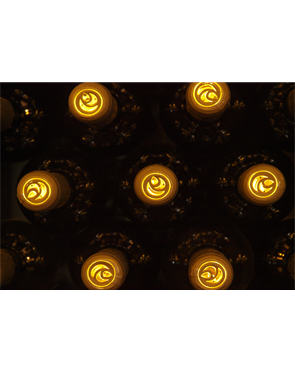
How to Store Wine
Wine is considered to be a "living" product, so when aging wine, we need to remember that no two wines are similar, not even two bottles of wine are alike. Each and every wine behaves differently during aging - some wines can improve over 20 years, while others are intended for consumption within 6 months. In order to know whether the specific wine is capable of aging over time, one must be familiar with the wine itself, its production and aging processes, and learn from the winery and wine critics, the estimated aging capability.
Wine in a bottle reacts to everything that is external - particularly to temperature, but also to humidity, light and vibrations. Therefore, we need to maintain all these factors when storing wine for an extended period of time.
Temperature - the highest temperature that wine can endure is 25 degrees. Above this temperature, the wine will start to change, and we will drink a "different" wine than that the winemaker had intended. In a hot country like Israel, this kind of temperature is not available all the time, and therefore storage at home should only be for a short period of time (a few months). It is recommended to place wine bottles in the coolest cabinets possible, even close to the floor, and not exposed to any heat source, such as strong lighting, sunlight or electrical appliances.
Temperature
The ideal temperature for long-term wine storage is between 13-16 degrees Celsius.
The lower the temperature, the slower the wine will evolve and mature. In wine cellars around the world, this temperature range comes naturally, but in Israel, such temperatures are hardly found without artificial refrigeration. Therefore, cooling systems or wine coolersshould be used. Only in a temperature range of 13-16 degrees, the wine can age over time, so there is no point in trying to age a wine that is not refrigerated.
In terms of temperature, white wine is similar to red wine, but in general, white wines are intended for shorter aging than red wines.
Light
Ultra violet rays (UV), that are found in the sun, but also in fluorescent lamps for example, cause unwanted changes in wine, and therefore bottles should be kept in the dark, or in refrigeration that has windows that filter the UV rays.
Humidity
The main reason why wine bottles require certain humidity are the corks. Other kinds of closuresdo not need a certain humidity level. As long as the bottle lies (which is the correct way to store a wine bottle), the cork stays wet and therefore swells, preventing increased oxygen entry to the bottle. Only in a very dry environment, the cork may dry out and cause the entry of harmful oxygen to the bottle, but these are extreme conditions.
Vibration
Too many movements to the wine may damage it, therefore it is recommended not to store the wine in a place that has permanent vibrations, such as a refrigerator with a compressor that is not equipped with a system used to treat vibrations.
"Long journeys" for the wine should be taken into consideration as well. After flights for example, it is important to lay the bottles to rest for several weeks, as it may be less pleasant to drink after many vibrations.
Serving
Before Opening...
Red wines and some white wines as well, should be opened some time before drinking, so that the wine can breathe. A half an hour for an opened bottle of wine is good for almost every wine, and some wines even benefit from 3-4 hours of airing. During this time, the wine releases its aromas, softens, and is just more pleasant to drink.
Temperature
White wine is served cold, as most people know... but what about red wine?
Many people believe that red wine should be served at room temperature, 25 degrees, but this is a common mistake. In fact, red wine should be served cool (in terms of Israeli temperatures), meaning 16-18 degrees, even lower at times.
If there is no wine coolerthat stores the wine in such a temperature, this temperature can be reached by placing the wine in a home refrigerator for an hour or two before drinking. It is always best for the wine to be cooler than warmer, because usually the room is warmer than the bottle and the bottle will warm up quickly.
Drinking “warm” wine emphasizes the alcohol and negative aromas, compared with positive fruity aromas that emerge, when the wine is served in the proper temperature.
Light and delicate red wines can be drunk in even lower temperatures.
White wine should be consumed at a temperature of 6-10 degrees, depending on its type, but one can cool the bottles in a home refrigerator up to 4 degrees, and any way the wine will warm up rapidly after a short time.
After Opening...
Wine that is left in a bottle, oxidizes very quickly. There are wines that improve after 24 hours in such a situation, similar to airing, but that is the limit. It is recommended to keep open bottles using a vacuum seal, which reduces the amount of oxygen in the bottle, and in a refrigerator, to try and delay the oxidation process. In this way the wine can be maintained for several days only.




